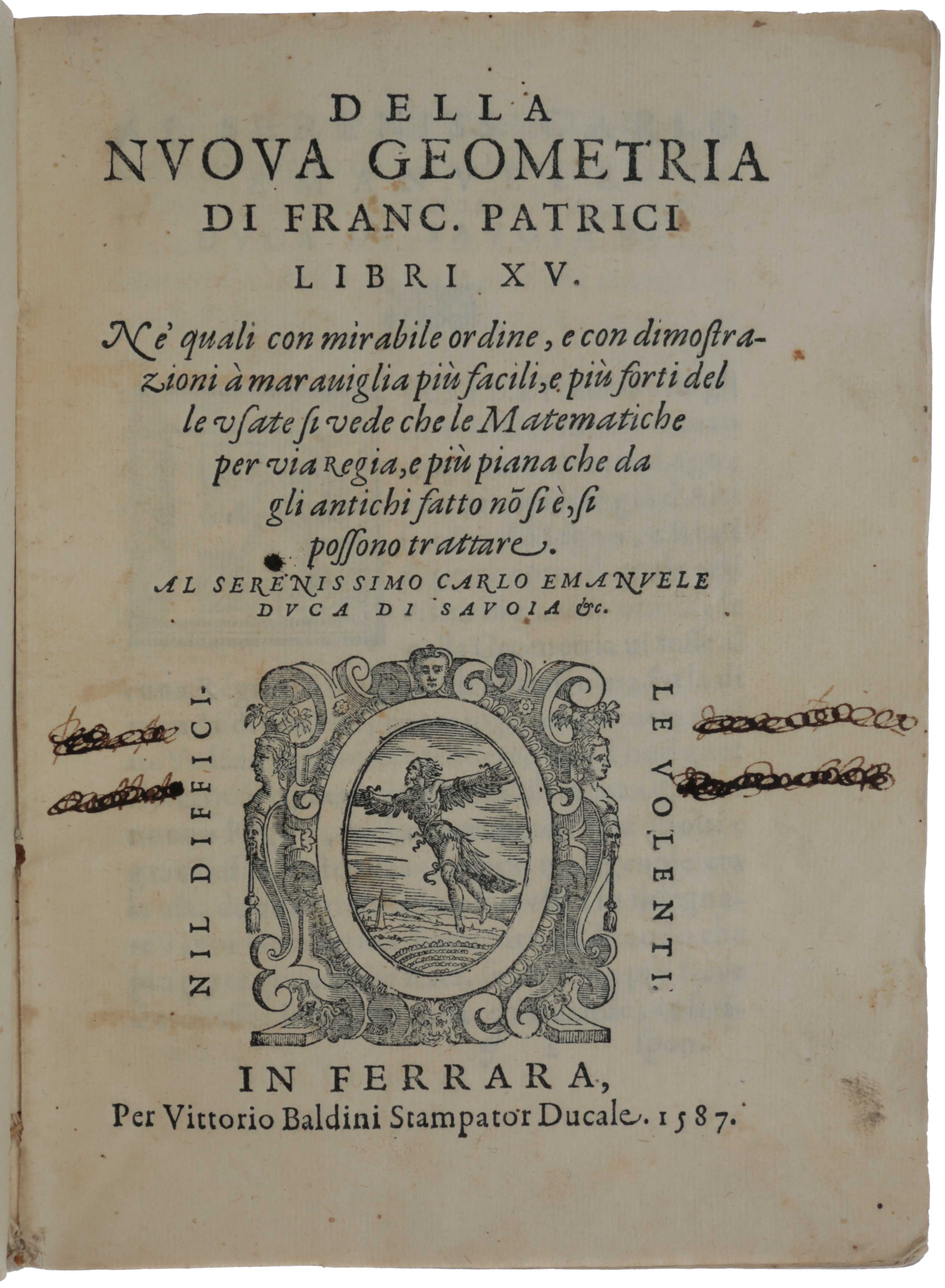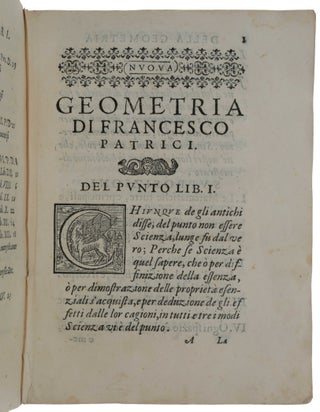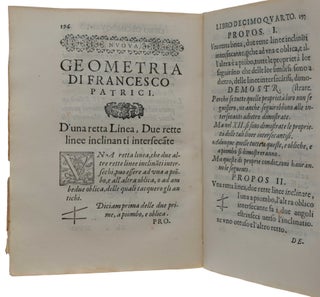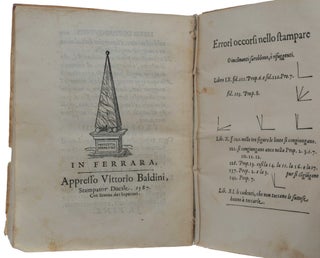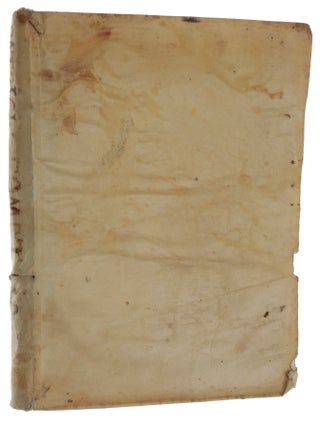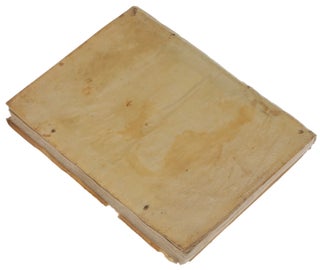Della Nuova Geometria Libri XV.
Ferrara: Vittorio Baldini, 1587 [but 1586]. First edition, very rare, of Patrizi’s important work on the concept of ‘space’, which is “one of the most significant and important documents for the history of mathematical epistemology in the Renaissance, and might indeed almost be considered the turning point and dividing line between ancient and modern geometry” (Prins, p. 56). “Patrizi’s importance in the history of science rests primarily on his highly original views concerning the nature of space, which have striking similarities to those later developed by Henry More and Isaac Newton. His position was first set out in De rerum naturae libri II priores, alter de spacio physico, alter de spacio mathematico (Ferrara, 1587) [although this was probably published after the Nuova geometria – see below]. Rejecting the Aristotelian doctrines of horror vacui and of determinate ‘place,’ Patrizi argued that the physical existence of a void is possible and that space is a necessary precondition of all that exists in it. Space, for Patrizi, was ‘merely the simple capacity (aptitudo) for receiving bodies, and nothing else.’ It was no longer a category, as it was for Aristotle, but an indeterminate receptacle of infinite extent. His distinction between ‘mathematical’ and ‘physical’ space points the way toward later philosophical and scientific theories. The primacy of space (spazio) in Patrizi’s system is also seen in his Della nuova geometria (Ferrara, 1587), the essence of which was later incorporated into the Nova de universis philosophia. In it Patrizi attempted to found a system of geometry in which space was a fundamental, undefined concept that entered into the basic definitions (point, line, angle) of the system. The full impact of Patrizi’s works on later thought has yet to be evaluated” (DSB). “Patrizi’s works seem to have been widely known throughout Europe and directly influenced some of the Cambridge Platonists, notably Joseph Glanville and Henry More. Henry More can be seen as a link between Patrizi and Sir Isaac Newton. Patrizi’s long arguments for an isotropic, unchanging, immobile and infinite space, his vehement denunciation of the Aristotelian concept, and his establishment of space as a new philosophical term can finally be said to have taken root when Newton was able to discuss absolute space after writing: I do not define space as being well known to all” (John Christopher Henry, Francesco Patrizi and the concept of space, doctoral thesis, University of Leeds, 1977, pp. 167-168). OCLC records eight US locations, at Chicago, Columbia, Wisconsin, Burndy, Michigan, Illinois, Temple, and Cornell, and a copy at the Fisher Library, Toronto. ABPC/RBH list just three other copies: Swann, 21 October 2014, lot 346, $20,000; Sotheby’s, 4 November 2004 (Macclesfield, part of a sammelband), £6250; Sotheby’s, 11 April 2002 (de Vitry), £2585. “Patrizi’s new geometry primarily presents a comprehensive axiomatic deductive system based on his own intuitive definitions of geometric concepts. As a religious mathematical realist, Patrizi holds that through the realization of these God given intuitions, or innate ideas, the mathematical structure of the universe can be obtained. First of all, he develops his geometric system in order to replace that of Euclid … Euclid’s Elements had disregarded the concepts of continuous quantity and infinity, proceeding from basic assumptions, axioms, and postulates to develop a strictly deductive geometric system. Even though Euclid’s axioms and postulates are faultless, Patrizi declares that the underlying philosophical foundation of Euclidean theory is not a suitable foundation for a science of geometry. He argues that although Euclid had defined all basic geometric concepts, including the point, line, surface and solid, he failed to formulate a proper philosophical system for defining all the other geometric concepts. In the history of thought, this was already often noted as a major logical shortcoming of Euclid’s geometry. There is indeed an unbridgeable gap between Euclid’s first seven definitions (of concepts such as point, line, and surface) in the first book of his Elements and the remaining definitions of the treatise. The former definitions concern only geometric concepts, which must be understood, in accordance with Aristotle, as abstractions from real things in the world. In line with this aversion to anything Aristotelian, Patrizi holds that such a system of definitions does not meet all formal logical requirements for a scientific geometry. In addition, he argues, as a mathematical realist against Aristotelian scholars, that the mathematics of the natural world is not something merely abstracted from bodies by the human mind, but that bodies themselves are constituted of mathematical space. Therefore, mathematics should precede natural philosophy. “In his Nuova geometria Patrizi defines points, lines, angles, surfaces, and solids as the subject matter of the discipline of geometry. He then goes on to argue that every space must have a minimum, maximum and mean. At this point in his explanation, he comes to the conclusion that each space must be one-dimensional (length), two-dimensional (length and breadth), or three-dimensional (length, breadth and depth) … Patrizi conceives of space as the first and most important undefined geometric concept which is lacking in Euclid’s Elements. Points, lines, angles, surfaces, and solids must all be related to space as their founding concept … Patrizi holds that space, rather than the structure of the World-Soul, must be the prime subject of mathematics” (Prins, pp. 259-260). “Aristotle’s philosophy of mathematics, which was the widest and most elaborate to be developed in the Classical Age and, what is more, the most influential for the following centuries, held the proper object of geometry to consist in magnitude, that is, in continuous quantity; in other words, it considered all the shapes and figures which elementary geometry studies (triangles, circles, and spheres) as exemplifications and instances of the common genus ‘magnitude’. Euclid’s Elements themselves … appeared to straightforwardly endorse the notion that it was just these magnitudes that formed the proper object, and the matter of the inquiry, of the science of geometry. The concept of (continuous) quantity, however, did not seem to have any connection with that of space (nor with that of position), and it was thus inconceivable that geometry would have to deal with such a concept … “[For the Neoplatonists, however,] magnitude is not a property of substance, but of matter itself. This thesis liberated, in principle at least, the consideration of magnitudes from that of individual, determinate bodies. Thus, it carried mathematics beyond the status of a theory of individual shapes or figures. This marked the birth of the idea of a quantified environment, in which the determinate figures and magnitudes which geometry examines are located … “The principal element of originality in Patrizi’s metaphysics of space consists in space’s ontological independence from bodies and from matter, and in the fact that this space is quantified and is, in effect, the foundation of the quantification and extension of everything which exists in it. From this, clearly, it directly follows that mathematics must be concerned with space itself, rather than with bodies or with extended corporeal matter. It is thus no surprise that Patrizi was eventually to arrive at the formulation of a new epistemology of geometry as the science of space. “The thesis that space is directly quantified but the matter located in it only indirectly so had vast implications for the general conception of science and nature. In particular, this leads to the idea that the world is mathematizable, and that it is possible to investigate its quantitative features precisely because it is in space. That is to say, geometry can be applied to the world because it can be applied to space, and space is the foundation of all bodies’ extension … We witness here, so to speak, a kind of ‘dress rehearsal’ of the epistemology of modern science … “This definition of geometry as the science of space may seem obvious today, but in the sixteenth century it was not. Patrizi was perhaps the very first to formulate it. It was a definition which gained broader acceptance in the course of the following century, although it met with some resistance too, and was at times defended precisely in Patrizi’s name. It then finally won the approval not only of philosophers, but also of geometers, who were able to substantiate with proofs and theorems the new geometry which Patrizi had left, in the moment of its birth, largely undefended. Finally, it succeeded in imposing itself as the commonly-accepted definition of the discipline, to such a point that it is nowadays difficult to imagine that geometry could be (and could have been for centuries) anything else than the science of space. In this sense, Patrizi gave birth to a new geometry, or rather laid the first epistemological and ontological foundations for such a geometry to be, first, fully theorized and then, eventually, actually implemented … “In France, [Patrizi’s] positions gained ground principally through the writings of Gassendi, who certainly makes a wide use of them (though without ever mentioning Patrizi) in the exposition of his theory of space, so similar to Patrizi’s, in the Syntagma philosophicum from 1649 … on the other hand, Mersenne made the effort to mount a complete refutation of Patrizi’s doctrines [in his Quaestiones celeberrimae in Genesim, 1623]. Most of all, however, Patrizi’s metaphysics later gained currency in Great Britain, and Gilbert, Bacon, Fludd, Digby, and Harriot and Warner, were acquainted with him while Hobbes appreciated him highly; his good fortune, however, was chiefly due to the large numbers of English Neoplatonists who embraced his spatial theories enthusiastically: Herbert of Cherbury, Joseph Glanvill, and certainly Henry More … Newton’s mentor, Isaac Barrow, certainly held modern positions about space, but in geometry he remained a classical Neoplatonist. On the other hand, Newton himself, who had studied all these English authors, especially More, and then Gassendi and scores of other readers of Patrizi, never once doubted that geometry is performed in space. Already his early writings betray a mathematical epistemology clearly Patrizian in spirit. Newton’s extraordinary fame was certainly instrumental in the definitive acceptance of the geometry of space by mathematicians and philosophers. “In the same years, moreover, Leibniz was developing a different theory of space and of geometry, but certainly agreed that the two needed to proceed hand in hand. It is not easy to ascertain the influence of Patrizi’s Nuove geometria on Leibniz’s attempts to develop an analysis situs. We do know that Leibniz read, admired – but also in certain respects scorned – Patrizi’s book; that he shared with him some epistemological views about mathematics; and that many geometrical concepts and definitions appear in almost identical forms in both works. We don’t know, however, when exactly Leibniz read the Nuova geometria and whether he was actually influenced by it in the making of his own (far superior) geometry of space … “The frontispiece [of the Nuova geometria] bears the date of 1587, but we know from Patrizi’s correspondence with the mathematician Giambattista Benedetti that, as early as July 1586, he was in a position to send him the first printed pages, and that the whole book had appeared by early December of that year. It is remarkable, however, that Patrizi affirms in the treatise on geometry that he presupposes therein some principles which he has, so he claims, already proven in his two books on space, since the latter had probably not yet appeared in print by the end of 1586. We may assume, therefore, that he had already written his metaphysical essays by the time of the composition of the Nuova geometria. Conversely, in the final sentence of the two booklets De spacio physico & mathematico, Patrizi noted that the Italian treatise Della nuova geometria was intended as the continuation of the essays on space” (Prins). Patrizi (1529-1597) studied at Ingolstadt, at the University of Padua (1547-1554), and at Venice. While in the service of various noblemen in Rome and Venice he made several trips to the East, where he perfected his knowledge of Greek, and to Spain. He lived for a time at Modena and at Ferrara, before being appointed to a personal chair of Platonic philosophy at the University of Ferrara by Duke Alfonso II d’Este in 1578. He remained there until 1592, when Pope Clement VIII summoned him to a similar professorship in Rome, a post he held until his death. Macclesfield 870; Poggendorff II, col. 374; Riccardi I 254 ("Bella e rara ediz. ommessa dal Brunet"); Sommerville p. 3; STC Italian p. 493; not in Adams. De Risi, ‘Francesco Patrizi and the New Geometry of Space,’ pp. 55-106 in Regier & Vermeir (eds.), Boundaries, Extents and Circulations, 2016. Prins, Echoes of an Invisible World: Marsilio Ficino and Francesco Patrizi on Cosmic Order and Music Theory, 2014.
4to (199 x 150 mm), pp. [8], 227, [1, errata], with woodcut device on title and woodcut diagrams in the text. Contemporary vellum with manuscript lettering to spine, some wear but entirely unrestored.
Item #4856
Price: $17,500.00

